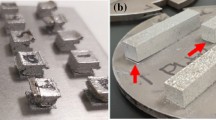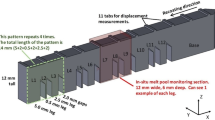Abstract
This research is devoted to forecast the distortion of aileron brackets by means of generative design (GD) and multi-scaled numerical simulation comprising meso- and macro-scaled simulation based on thermomechanical method (TMM) and inherent strain method (ISM), respectively. The multi-scaled simulation began with TMM-based virtual calibration test (VCT) including mesh sensitivity and volume fraction analysis to identify the best meshing voxel size. In finding inherent strain tensors, optimization was implemented using pattern search algorithm referring to the minimum relative error. Further, macro-scaled simulation was implemented to estimate bracket distortion behavior by applying the inherent strain tensors in ISM. For experiment, the conventional aileron bracket shape was first improved by complying the internal rules of GD throughout the desired design space with respect to stress goal and weight reduction based on iterative material distribution. After obtaining the new generatively designed component, linear static analysis was implemented to improve the stress magnitude and surface smoothness level by mesh and material sculpting. Then, the component is manufactured using laser powder bed fusion with manual postprocessing of support structure followed by sand blasting. The finished aileron bracket was then measured using a 3D scanner GOM Atos Q. As conclusion, this novel multi-scaled simulation method based on GD, static stress, and virtual calibration test allows a forecast of an acceptable surface deviation within relative single point and mean errors up to 11% and 5% respectively. By neglecting the tedious and time-consuming procedure of real calibration, a huge time reduction for preparation up to a few days and for computation up to 35% compared to pure TMM can be achieved.



















Similar content being viewed by others
Data availability
Not applicable.
Code availability
Not applicable.
References
Davies CM, Withnell O, Ronnerberg T, Williams R, Hooper PA (2018) Fracture analysis of 316l steel samples manufactured by selective laser melting. Procedia Struct Integr 13:1384–1389
Fereiduni E, Ghasemi A, Elbestawi M (2020) Selective laser melting of aluminum and titanium matrix composites: recent progress and potential applications in the aerospace industry. Aerospace 7(6):77
Wan HY et al (2022) Toward qualification of additively manufactured metal parts: tensile and fatigue properties of selective laser melted inconel 718 evaluated using miniature specimens. J Mater Sci Technol 97:239–253
Liu J, Gaynor AT, Chen S et al (2018) Current and future trends in topology optimization for additive manufacturing. Struct Multidisc Optim 57:2457–2483
Ntintakis I, Stavroulakis GE (2020) Progress and recent trends in generative design. MATEC Web Conf 318:01006
Buonamici F, Carfagni M, Furferi R, Volpe Y, Governi L (2020) Generative design: an explorative study. Comput Aided Des Appl 18(1):144–155
Kallioras NA, Lagaros ND (2020) DzAIℕ: deep learning based generative design. Procedia Manuf 44:591–598
Zhu L, Li N, Childs PRN (2018) Light-weighting in aerospace component and system design. Propuls Power Res 7(2):103–119
Dubrovskaya A, Dongauzer K, Faskhutdinov R (2017) The design of lightweight gas turbine engine parts using topology optimization. MATEC Web Conf 129. https://doi.org/10.1051/matecconf/201712901067
Chen Y, Wang Q, Wang C et al (2021) Topology optimization design and experimental research of a 3d-printed metal aerospace bracket considering fatigue performance. Appl Sci 11(15):6671. https://doi.org/10.3390/app11156671
Li C, Liu JF, Guo YB (2016) Prediction of residual stress and part distortion in selective laser melting. Procedia CIRP 45:171–174
Zhang Y, Chen Q, Guillemot G, Gandin CA, Bellet M (2018) Numerical modelling of fluid and solid thermomechanics in additive manufacturing by powder-bed fusion: continuum and level set formulation applied to track- and part-scale simulations. Comptes Rendus - Mec 346(11):1055–1071
Li C, Liu JF, Guo YB (2016) Efficient multiscale prediction of cantilever distortion by selective laser melting. In: Proceedings of the 27th Annual International Solid Freeform Fabrication Symposium, pp 236–246
Li C, Fu CH, Guo YB, Fang FZ (2015) A multiscale modeling approach for fast prediction of part distortion in selective laser melting. J Mater Process Technol 229:703–712
Lindgren L, Malmelöv A, Lundbäck A (2020) History reduction by lum** for time-efficient. Metals (Basel) 10(58):1–17
Liang X, Hayduke D, To AC (2021) An enhanced layer lum** method for accelerating simulation of metal components produced by laser powder bed fusion. Addit Manuf 39:101881
Papadakis L, Loizou A, Risse J, Bremen S, Schrage J (2014) A computational reduction model for appraising structural effects in selective laser melting manufacturing. Virtual Phys Prototyp 9(1):17–25
Ma N, Deng D, Osawa N, Rashed S, Murakawa H, Ueda (2022) Introduction to welding mechanics. In: Welding deformation and residual stress prevention, 2nd Edn, pp 1–35
Hill MR, Nelson DV (1999) The inherent strain method for residual stress determination and its application to a long welded joint. ASME Publications, PVP, vol 318, pp 343–352
Pagac M et al (2021) Prediction of model distortion by FEM in 3D printing via the selective laser melting of stainless steel AISI 316L. Appl Sci 11(4):1–16
GhGhanbari P, Mazza E, Hosseini E (2020) Adaptive local-global multiscale approach for thermal simulation of the selective laser melting process. Addit Manuf 36:101518
Varma AS, Sathyanarayana GS, Sandeep J (2016) CFD analysis of various nose profiles. Int J Aerosp Mech Eng 3(3)
Reshid M et al (2020) Mass reduction of a jet engine bracket using topology optimisation for additive manufacturing application. Int J Adv Sci Technol 29(8s):4438–4444
Taufek T et al (2022) Distortion analysis of generatively designed hinge bracket using meso-scaled thermomechanical simulation with experimental validation. Virtual Phys Prototyp 17(4):966–988
Klippstein H, Duchting A, Reiher T, Hengsbach F, Menge D, Schmid H (2019) Development, production and post-processing of a topology optimized aircraft bracket. In: 30th annual international solid freeform fabrication symposium, pp 1932–1945
Masoomi M, Thompson SM, Shamsaei N, Elwany A, Bian L (2020) An experimental-numerical investigation of heat transfer during selective laser melting. In: Proceedings 26th International Solid Freeform Fabrication Symposium - An Additive Manufacturing Conference, pp 229–242
Ansari MJ, Nguyen DS, Park HS (2019) Investigation of SLM process in terms of temperature distribution and melting pool size: modeling and experimental approaches. Materials (Basel) 12(8):1272
Neugebauer F, Keller N, Ploshikhin V, Feuerhahn F, Köhler H (2014) Multi scale FEM simulation for distortion calculation in additive manufacturing of hardening stainless steel. In: Proceeding International Workshop on Thermal Forming an Welding Distortion, pp 1–11
Chiumenti M et al (2017) Numerical modelling and experimental validation in selective laser melting. Addit Manuf 18(October):171–185
Simufact Additive Manufacturing, Voxel Meshing Parameters, Infosheet, pp 1–3
Zhu J, Khurshid M, Barsoum Z (2019) Accuracy of computational welding mechanics methods for estimation of angular distortion and residual stresses. Weld World 63(5):1391–1405
Diekmann U (2012) Calculation of steel data using JMatPro. Comat 2012 - International Conference Recent trends Struct Mater
Ravichandran K (2021) Calibrating inherent strain for additive manufacturing an investigation of different subscale geometries. Department of Industrial and Materials Science, Chalmers University of Technology
Murakawa H (2013) Residual stress and distortion in laser welding. Handb Laser Weld Technol 2:374–398
Nelder JA, Mead R (1965) A simplex method for function minimization. Comput J 7(4):308–313
Liang X, Chen Q, Cheng L et al (2019) Modified inherent strain method for efficient prediction of residual deformation in direct metal laser sintered components. Comput Mech 64:1719–1733
Deng D, Murakawa H (2008) Prediction of welding distortion and residual stress in a thin plate butt-welded joint. Comput Mater Sci 43(2):353–365
Vega Sáenz A, Plazaola C, Banfield I, Rashed S, Murakawa H (2012) Analysis and prediction of welding distortion in complex structures using elastic finite element method. Cienc y Tecnol buques 6(11):35
Liang X, Cheng L, Chen Q, Yang Q, To AC (2018) A modified method for estimating inherent strains from detailed process simulation for fast residual distortion prediction of single-walled structures fabricated by directed energy deposition. Addit Manuf 23:471–486
Michaleris P (2014) Modeling metal deposition in heat transfer analyses of additive manufacturing processes. Finite Elem Anal Des 86:51–60
Denlinger ER, Irwin J, Michaleris P (2014) Thermomechanical modeling of additive manufacturing large parts. ASME J Manuf Sci Eng 136(6)
Papadakis L, Hauser C (2017) Experimental and computational appraisal of the shape accuracy of a thin-walled virole aero-engine casing manufactured by means of laser metal deposition. Prod Eng 11(4–5):389–399
Taufek T et al (2022) “Modeling and simulation of additively manufactured cylindrical component using combined thermomechanical and inherent strain method with nelder–mead optimization”, 3D Print. Addit Manuf 00(00):1–14
Ueda Y, Fukuda K, Tanigawa M (1979) New measuring method of three dimensional residual stresses based on theory of inherent strain. Trans JWRI 8(2):89–96
Acknowledgements
The authors would like to express their gratitude to staff members of Smart Manufacturing Research Institute (SMRI) and Research Interest Group: Advanced Manufacturing Technology (RIG:AMT) at School of Mechanical Engineering, Universiti Teknologi MARA (UiTM) Shah Alam, as well as Professorship of Virtual Production Engineering at Chemnitz University of Technology (CUT) in Germany for encouraging this research.
Funding
There was partial funding for this study. This research is financially supported by Konsortium Kecemerlangan Penyelidikan Grant Scheme (Large Volume Additive Manufacturing/LVAM, No. KKP001A-2021) from the Ministry of Higher Education (MOHE) in Malaysia and Geran Penyelidikan Khas (Correlation of Distortion and Deformability in Hollow 316L Wire Arc Additive Manufacturing (WAAM) Model Based Numerical Simulation, No. 600-RMC/GPK 5/3 123/2020) from UiTM.
Author information
Authors and Affiliations
Corresponding author
Ethics declarations
Ethical approval
This article does not contain any studies with human participants or animals performed by any of the authors.
Consent to participate
Not applicable.
Consent for publication
Not applicable.
Conflict of interest
The authors declare no competing interests.
Additional information
Publisher's Note
Springer Nature remains neutral with regard to jurisdictional claims in published maps and institutional affiliations.
Rights and permissions
Springer Nature or its licensor (e.g. a society or other partner) holds exclusive rights to this article under a publishing agreement with the author(s) or other rightsholder(s); author self-archiving of the accepted manuscript version of this article is solely governed by the terms of such publishing agreement and applicable law.
About this article
Cite this article
Manurung, Y.H.P., Taufek, T., Adenan, M.S. et al. Optimizing novel multi-scaled simulation method for deviation analysis of generatively designed aileron bracket using laser powder bed fusion. Int J Adv Manuf Technol 132, 5855–5871 (2024). https://doi.org/10.1007/s00170-024-13714-5
Received:
Accepted:
Published:
Issue Date:
DOI: https://doi.org/10.1007/s00170-024-13714-5




